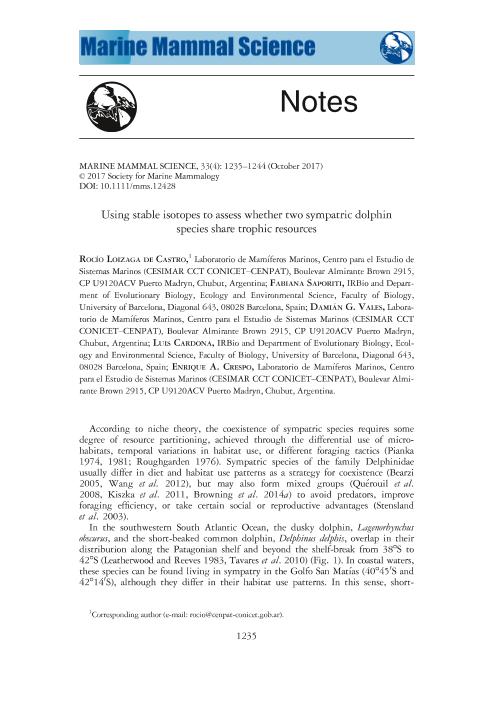Mostrar el registro sencillo del ítem
dc.contributor.author
Loizaga de Castro, Rocio

dc.contributor.author
Saporiti, Fabiana

dc.contributor.author
Vales, Damián Gustavo

dc.contributor.author
Cardona, Luis

dc.contributor.author
Crespo, Enrique Alberto

dc.date.available
2018-11-28T18:54:28Z
dc.date.issued
2017-10-07
dc.identifier.citation
Loizaga de Castro, Rocio; Saporiti, Fabiana; Vales, Damián Gustavo; Cardona, Luis; Crespo, Enrique Alberto; Using stable isotopes to assess whether two sympatric dolphin species share trophic resources; Wiley Blackwell Publishing, Inc; Marine Mammal Science; 33; 4; 7-10-2017; 1235-1244
dc.identifier.issn
0824-0469
dc.identifier.uri
http://hdl.handle.net/11336/65496
dc.description.abstract
In the southwestern South Atlantic Ocean, the dusky dolphin, Lagenorhynchus obscurus, and the short-beaked common dolphin, Delphinus delphis, overlap in their distribution along the Patagonian shelf and beyond the shelf-break from 38°S to 42°S. In coastal waters, these species can be found living in sympatry in the Golfo San Matıas (40°450S and 42°140S), although they differ in their habitat use patterns. In this sense, short-beaked common dolphins prefer habitats located in the northwest section of the gulf far from the coast; whereas dusky dolphins prefer areas with steep slopes close to the coast in the southwestern sector of the gulf.
dc.format
application/pdf
dc.language.iso
eng
dc.publisher
Wiley Blackwell Publishing, Inc

dc.rights
info:eu-repo/semantics/openAccess
dc.rights.uri
https://creativecommons.org/licenses/by-nc-sa/2.5/ar/
dc.subject
Dusky Dolphin
dc.subject
Lagenorhynchus Obscurus
dc.subject
Short-Beaked Common Dolphin
dc.subject
Delphinus Delphis
dc.subject
Feeding Habits
dc.subject
Isotop Analysis
dc.subject.classification
Otras Ciencias Biológicas

dc.subject.classification
Ciencias Biológicas

dc.subject.classification
CIENCIAS NATURALES Y EXACTAS

dc.title
Using stable isotopes to assess whether two sympatric dolphin species share trophic resources
dc.type
info:eu-repo/semantics/article
dc.type
info:ar-repo/semantics/artículo
dc.type
info:eu-repo/semantics/publishedVersion
dc.date.updated
2018-10-29T17:01:42Z
dc.identifier.eissn
1748-7692
dc.journal.volume
33
dc.journal.number
4
dc.journal.pagination
1235-1244
dc.journal.pais
Reino Unido

dc.journal.ciudad
Londres
dc.description.fil
Fil: Loizaga de Castro, Rocio. Consejo Nacional de Investigaciones Científicas y Técnicas. Centro Científico Tecnológico Conicet - Centro Nacional Patagónico. Centro para el Estudio de Sistemas Marinos; Argentina
dc.description.fil
Fil: Saporiti, Fabiana. Universidad de Barcelona; España
dc.description.fil
Fil: Vales, Damián Gustavo. Consejo Nacional de Investigaciones Científicas y Técnicas. Centro Científico Tecnológico Conicet - Centro Nacional Patagónico. Centro para el Estudio de Sistemas Marinos; Argentina
dc.description.fil
Fil: Cardona, Luis. Universidad de Barcelona; España
dc.description.fil
Fil: Crespo, Enrique Alberto. Consejo Nacional de Investigaciones Científicas y Técnicas. Centro Científico Tecnológico Conicet - Centro Nacional Patagónico. Centro para el Estudio de Sistemas Marinos; Argentina
dc.journal.title
Marine Mammal Science

dc.relation.alternativeid
info:eu-repo/semantics/altIdentifier/doi/https://dx.doi.org/10.1111/mms.12428
dc.relation.alternativeid
info:eu-repo/semantics/altIdentifier/url/https://onlinelibrary.wiley.com/doi/full/10.1111/mms.12428
Archivos asociados
